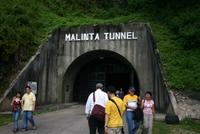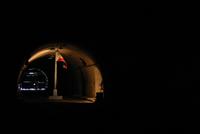Big caves, big falls, big mountains, big everything… Sagada is one big adventure for city dwellers like me. But the metro habits of sight-seeing, shopping and dinning are things not to be belittled in Sagada. The town is not a commercialized place – thank God! You won’t find gaudy looking fast food outlets, expensive shops, fancy restaurants or banks here. But still,
Sagada is the “it” place in these remote region of the Cordillera Mountain ranges.
After scrubbing off all the dirt from the long hike in Bomod-ok Falls, some friends and I hit the streets of the town to find fab souvenirs and take pictures of the town’s landmarks. Unfortunately, I wasn’t able to get good photos since I ran our of batteries & my camera won’t flash anymore… that’s why I’m borrowing photos from fellow Sagada travelers to show you some of the places I crashed into.
St. Mary’s Church

You wouldn’t miss this prominent structure that is visible from town proper. Situated within the
Mission Compound, St. Mary’s is actually an Episcopal Church. Also found within the compound are
St. Mary's School, the
town cemetery,
Calvary and the alleged
bottomless pit of Kingkitongan. It is also in St. Mary’s wherein my friends and I met
Dominic – our fury friend living within the vicinity of the church. He would follow us wherever we would go. Dominic does not beg for alms or food - he is actually an adorable sheep! It’s quite amazing - my first time to see and touch a live sheep – and it happened here in Sagada.
Souvenirs and Pasalubong

I bought a couple of shirts and wooden key chains as
pasalubong from a side store near the
Sagada Hospital. But for travelers with taste for better native stuff, the
Sagada Weaving Store is the place for you. While shopping, you can witness an actual demonstration of old-fashioned weaving. Take note though, Sagadans don’t like to have their pictures taken. To them, having their photographs taken is tantamount to losing a part of their soul. So don’t get offended when they refuse to be photographed while weaving.
A grand feast
A celebration is just fitted to conclude our Sagada voyage. So we have decided to have our final dinner at one of the town’s prominent hotel/resto – a
European Inn near the town hall. We had such a grand feast – a banquet of fresh vegetables, pasta, imported cheese and bread, exotic dips, roasted beef and wine. To continue our merry-making, we decided to buy additional drinks from a local store and brought it to our rooms after the sumptuous dinner we had.
We had all the reasons to be merry – we have enjoyed our moments in Sagada to the fullest!
I know there are still places left unexplored during this visit. Nevertheless, I know, one day I will be back and will not fail to visit these spots that I have missed:
The
Kiltepan Rice Terraces are arguably the most extensive found in Sagada. The name was derived from the three bounding barangays:
KIlong, Te
TEP-an, and
ANtadao. Though I managed to take a picture of this valley, it’s another great feat if I could trek the terraces the next time I visit.

The
Echo Valley Hanging Coffins takes a little bit of adventurous spirit to be able to reach it. Hidden in the dense foliage of the valley, the hanging coffins are "hanged" from the limestone cliff using slabs driven into the rocks. Again, pictures where only taken and I promise not to miss this place again when I get back.

Visitors may follow the underground river in Latang upstream leading to
Bokong waterfalls (or “small falls”). There are three natural diving spots - the highest of which require for the diver to run and jump far enough over some bushes to be able to reach the pool below. It’s much easier to reach the small falls compared to the big falls in Banga-an.
I should also visit
Lake Danum located on the outskirts of Sagada. On the road going to the neighboring town of Besao, you can already take a glimpse of this dying lake.
And lastly,
Mount Ampakaw – the tallest mountain in Sagada; locals say that this is an ideal picnic place during the months of April and May when the summer sun is pleasant and the blackberries are ripe for picking. Can't wait for that to happend. See you next time, Mt. Ampakaw!
That concludes my Sagada Blog series. Well, it’s only the beginning, there’s so much more places that I would be sharing and blogging about. So just hang on…
 The Pacific War Memorial on the center of the island stands as one of the greatest monuments of heroism and love for freedom.
The Pacific War Memorial on the center of the island stands as one of the greatest monuments of heroism and love for freedom.
 In another part, a vast garden lies as a symbolic gesture of Japan’s remorse for the destruction they have brought to our people.
In another part, a vast garden lies as a symbolic gesture of Japan’s remorse for the destruction they have brought to our people.  But nothing can compare to the “Malinta Tunnel Experience” – a 30 minute light and sound presentation inside the Malinta Tunnel itself.
But nothing can compare to the “Malinta Tunnel Experience” – a 30 minute light and sound presentation inside the Malinta Tunnel itself.  The smoke and dust effects added texture to the light and sound show, letting the tourist experience more intensely the narration about the fall of the island, the dramatic stories of soldiers during the war, and the great victory from the oppressors. The presentation ends with the playing of the Philippine National Anthem, a moment that would make every Filipino present very proud.
The smoke and dust effects added texture to the light and sound show, letting the tourist experience more intensely the narration about the fall of the island, the dramatic stories of soldiers during the war, and the great victory from the oppressors. The presentation ends with the playing of the Philippine National Anthem, a moment that would make every Filipino present very proud.
 The hospital complex lies on top of a hill, but is enclosed by thick forest trees. The main path is almost unnoticed and enclosed by entangled shrubs and enormous tree roots that sprang out from the ground. Finding the hospital itself is a daunting adventure.
The hospital complex lies on top of a hill, but is enclosed by thick forest trees. The main path is almost unnoticed and enclosed by entangled shrubs and enormous tree roots that sprang out from the ground. Finding the hospital itself is a daunting adventure.


 What is left of the hospital are vast, dark and empty halls, punctured walls and columns resembling a skeleton of its remains. I couldn’t think but imagine how once it sheltered the injured especially during the heated moments of the war. Maybe the hallways of the hospital were filled with crying soldiers wounded from battle, while doctors and nurses run about to tend the more serious patients. I felt that Tita Judith, being a nurse herself, was moved by this experience.
What is left of the hospital are vast, dark and empty halls, punctured walls and columns resembling a skeleton of its remains. I couldn’t think but imagine how once it sheltered the injured especially during the heated moments of the war. Maybe the hallways of the hospital were filled with crying soldiers wounded from battle, while doctors and nurses run about to tend the more serious patients. I felt that Tita Judith, being a nurse herself, was moved by this experience.
 Only the whistle of the wind and chirps of birds were the sounds I heard that morning. There were no more screaming and other traces of human suffering left, but these will be forever etched on the sides and pillars of the ruins. I kept on telling Greg to take pictures in conspicuous spots – chances are the ghosts we’re seeking might appear on one of his photos.
Only the whistle of the wind and chirps of birds were the sounds I heard that morning. There were no more screaming and other traces of human suffering left, but these will be forever etched on the sides and pillars of the ruins. I kept on telling Greg to take pictures in conspicuous spots – chances are the ghosts we’re seeking might appear on one of his photos.












